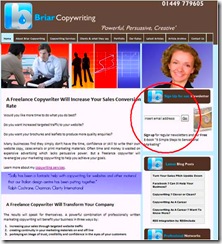Entries from January 2010 ↓
January 29th, 2010 — copywriting, copywriting tips, freelance copywriting

The debate about which is best, long or short, copy is one that is bound to rattle on for many years to come. Often what it comes down to is personal preference.
Many people claim that short copy will win hands down every time because:
- Nobody reads long copy
- If it’s an advert is has to be short copy
- People are too busy to read long copy
Well for a start someone must read long copy because it does its job (writers arguably make more from long copy that short). Plus, if by claiming adverts must be short, does that mean because people won’t read long adverts they’ll automatically read short ones? And by the same token, just because people are too busy to read long copy do they have time to read short?
Getting it all into perspective
When people talk about long copy they immediately visualise sales letters that go on for eternity. But that doesn’t have to be the case.
A long piece of copy could refer to a two page sales letter as opposed to a ten page one. Or it could equally refer to a twenty line email rather than an eight line email.
Size doesn’t matter
The main importance of any sales communication (whatever form it takes) is that it is relevant to the market. If you wrote a short, snappy and powerful advert that was totally irrelevant to its audience it wouldn’t work. If you wrote a six page sales letter that was completely irrelevant that wouldn’t work either.
Therefore its relevance is more important than its length.
So, when discussing the merits of long or short copy you would consider it as longer or shorter copy. But it is the relevancy of the information it contains that is more important here.
Your sales message should be as long as is necessary to get your audience to reach a buying decision and hand over their credit card.
Sally Ormond – freelance copywriter
January 27th, 2010 — copywriting tips, email marketing, freelance copywriting

The best time to send your email can depend on a number of factors:
- who your audience is
- what your content is
- why you’re sending the email…
The best way to discover the optimum time and day is through asking your recipients and trial and error.
A general rule of thumb
This ‘general rule of thumb’ is the one I work from. You may have different ideas to me and experiences. If you do please comment below because I’d love to hear your take on this subject.
Generally I send out my emails during the working week. Not everyone is a workaholic (says she as she types this on a Sunday afternoon), so I always avoid sending out business communications such as email marketing at the weekend.
I find the best days are Tuesday, Wednesday or Thursday, with Tuesday and Thursday being my preferred days.
Why not Monday?
Look at your Monday – what are you normally doing? It’s the first day back in the office after the weekend. You’ll probably spend the day finishing off last weeks jobs before you even start looking through your new batch of emails.
If you do get to your emails I bet you just give them a cursory glance and pick our the most important ones. Considering how much work you have to get through that week, you’ll probably also delete those which you won’t have time to look at – i.e. the newsletters! (this is where it pays to spend extra time working on your eye-catching headline).
Why not Friday?
The same kind of thing as above – you’re now winding down for the weekend trying to finish off those last minute jobs that landed on your desk at lunchtime. You don’t have time for newsletters and marketing emails now and you definitely don’t want to see them on Monday morning so they end up being deleted.
Tuesday and Thursday then
In my experience, Tuesday and Thursday are the best days. Why? Who knows – perhaps you’re more into your stride by then or you have more time on those days. But it seems to work for me.
Remember though, there is only one way to really discover the optimum time to send your communications and that’s by testing. Try it and test it – who knows you may come up with completely different results to me.
Everyone’s market is different so testing is the only way to determine what will really work for you. But it’s also important to keep testing. Different times of year could return different results.
Sally Ormond – freelance copywriter
January 25th, 2010 — copywriting tips, email marketing, freelance copywriting

The best way to dive into email marketing is to build your own opt-in list.
Sure, if you wanted to cut corners you could buy in a list or two – but do you really know what you’re getting?
The best and safest way to market your business through email is by utilising a list you have developed.
Great! So how do you start getting a list like that. It’s all very well in theory but creating a good list takes time. But at least you know that by doing it this way, you’ll have a list that is qualified and interested in what you’re offering.
How do I build my list and stop people from unsubscribing?
First, let’s make it clear that when you produce your newsletter you must have an unsubscribe button on it. You won’t be able to please all of the people all of the time. Your news and information may only be relevant for a certain period for some people so don’t be too disheartened if you get a few people unsubscribing from your list.
Really the first thing you have to worry about is getting people to hand over their email addresses in the first place.
Why should they give you their address? The information or offers you have for them must be relevant and useful otherwise why should the bother? It would also be a good idea to give them something – e.g. a free report, eBook etc.
Give them great content
Every issue of your newsletter must contain information that is interesting and relevant to your reader. If you promise insights into SEO and give them the latest news on Wall Street they’ll get a bit hacked off and unsubscribe.
Make every page of your website count
Get your opt-in form on every page of your site – in the same place. And make sure it’s easy to find – if you’re offering a free report/eBook make sure you show that too. Why not add them to your social media pages too such as Facebook.
Don’t make the sign up process complicated – a simple name and email address will suffice.

Psst, pass it on…
If your subscribers like your content, the chances are others will as well. Ask them to spread the work and “pass it on” to their friends and colleagues. This kind of viral marketing can be very powerful and help you grow a list quickly.
Use a squeeze page
There is only one goal for a squeeze page and that is to get opt-ins. It’s a bit like a mini sales letter. It has a strong headline followed by tantalising benefits. Research your keywords and invest in a bit of pay-per-click and you’re away.
To give it an extra boost add in a few testimonials too. You can also add video.
Blog
Blogging will generate interest and traffic to your site. If your blog is on a different URL to your website why not include a sign up box there too?
So there you go – just a few ideas to help you grow a home cultivated email marketing opt-in list.
Can you think of any other way of generating your list? If so why not post a comment and share your ideas with everyone.
Sally Ormond – freelance copywriter
January 22nd, 2010 — copywriting, copywriting tips, freelance copywriting

As copywriter’s we know what our audience wants, right?
All we have to do is give them an unbelievably good offer and they’ll say yes. They’ll identify our product with the life they’ve always wanted to live so they’ll snap our hand off just to get it.
Great – but is it?
Does life really happen like that?
Wake up to the real world
There is a problem here; one that you may not have thought of.
What if they really don’t what your product?
“Ha! Of course they do – how can they possibly refuse the offer?”
Oh boy, there’s the problem straight away. You’re assuming they’ll buy your product no matter what.
You can’t lead a horse to water…
OK, I don’t have a horse but that heading sounded better than “You can’t lead a Spaniel to a tablet”.
Take my Springer Spaniel, Jerry (yes, he’s Jerry Springer) – he may not be the most intelligent dog in the world but he knows about medicine. Just like a kid, when he’s given a course of tablets from the vet, he’ll do anything to avoid taking them (not that I take my kids to the vet, it’s just that they know medicine usually tastes horrible and really don’t want to take it).
Put it in his bowl of biscuits and he’ll eat every crumb but leave the pill. Put it inside a piece of cheese and he’ll eat round it.
The trick is to find something he will eat (please note this is not a problem with my other dog, Scooby. But then again he is a Labrador and will eat anything). I have learned to tailor my ‘sales pitch’ to him.
The only way I can get him to take his medicine is by grinding up his tablet and sprinkling it on a piece of bread thickly spread with Marmite. Hand that to him and he’ll take your hand off and love you forever.
At the end of the day, if you pitch the wrong product to your audience they won’t buy it.
Pitch correctly, to the correct audience and you’ll end up with a loyal customer base that’ll come back again and again. They’ll value the product you sold them, remember you as a company that ‘doesn’t force their products down their throats’ and will trust you for future purchases.
Remember then, people not buying doesn’t necessarily mean your copy is poor or your offer is weak. You can’t make people buy simply because you want them to. Make sure you research your market thoroughly – make timely offers to the right audience and you’ll grow a marketing list that’s worth its weight in gold.
Sally Ormond – freelance copywriter
January 20th, 2010 — copywriting, facebook, social media
As a freelance copywriter, I use social media to promote my company and the services I provide. Up to now that has been mainly through blogging, article marketing, bookmarking, Twitter, online forums and networking sites. But there was one outlet I hadn’t delved into – Facebook. I am on facebook in a personal capacity but had never considered it for business use – until now.
Can facebook really help businesses?
Before I go any further, I’m not an expert on using facebook fan pages – I’m still learning myself. But with the growing popularity of social media marketing I realised that it was something I was going to have to get to grips with sooner or later.
Facebook pages seem to becoming increasinglt the second home page for businesses online. As such, SEO is an important factor in the design of your page. So how do you squeeze the most SEO benefits out of your facebook page? Well here are a few pointers to kick you off:
- Choose a great name and stick to it – your business name is ideal.
- Pick the best URL possible. Now, if you have 25 fans or more, you can choose your own URL (mine is http://www.facebook.com/freelancecopywriting) in which yo ucan incorporate you keywords.
- Make your About Us box count – this is prime realestate for your keywords so use it wisely.
- The info tab should include http’s of related websites and specific information such as your keywords, geographical location etc.
- Post direct links to your website from your page.
- Use your facebook badge of your websites to show people you’re there.
Is it really worth it?
Well, here are 11 mindblowing reasons your business needs Facebook curtesy from Social Media Examiner:
- There are over 350,000 million global users of facebook
- There are 100,000 users in the US alone
- The average facebook user spends a staggering 55 minutes on it every day
- Nearly 80,000 sites use facebook connect
- Facebook fan box is becoming pervasive
- The average facebook user has 130 friends
- The average facebook user “fans” 2 pages per month
- Only 4% of pages have 10,000 or more fans
- Wall posts do’t impact popularity so make use of video, photos and links
- Customised news feeds
- Real-time search ability changes the game completely
Beginning to see how it will help your business?
Get yourself a fan page today like mine – see how you get one with it. Why not come back here and tell us all about your experiences and any tips you have picked up along the way.
Briar Copywriting – Leading UK Freelance Copywriter

Promote Your Page Too










